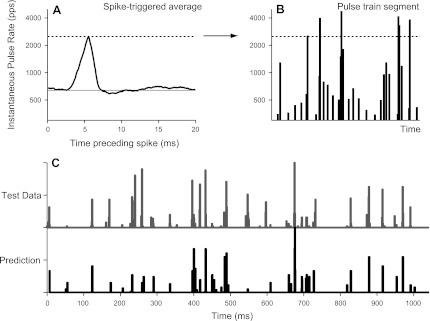Fig. 12.
Short interpulse intervals mediated the effect of jitter on the response of this neuron. A: spike-triggered average of the instantaneous stimulus pulse rate in response to 120 s of continuous (nonrepeating) jitter. The average neural spike was preceded by a rapid increase in pulse rate (i.e., short interpulse intervals). The horizontal line shows the mean stimulus pulse rate (640 pps). B: generation of a predicted response to an independent 1-s jittered pulse train token. Vertical lines represent individual stimulus pulses. Line heights indicate the instantaneous pulse rate (the reciprocal of the preceding interpulse interval). Pulse train thresholded at the peak amplitude of the spike-triggered average (dashed line) and then rectified and smoothed. C: comparison of predicted and actual PSTHs in response to independent jitter token. The short interpulse intervals accurately predicted the sparse, preferred firing times.

